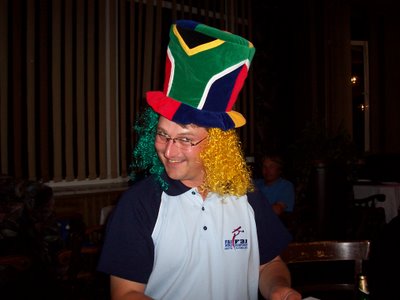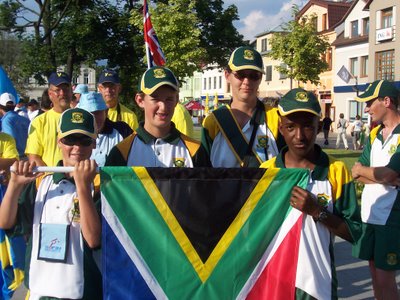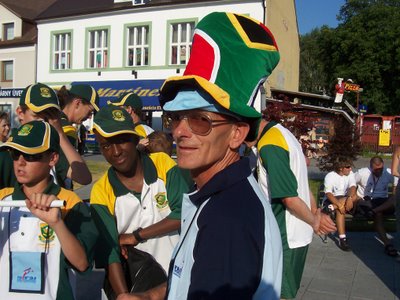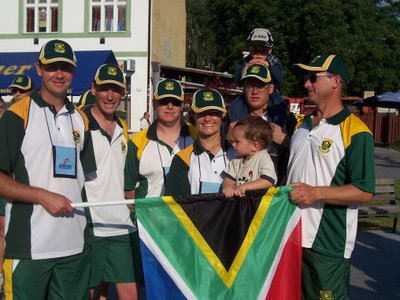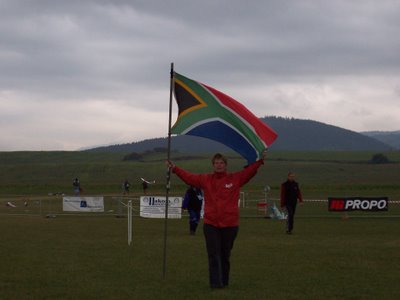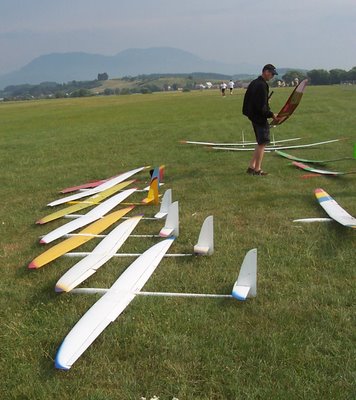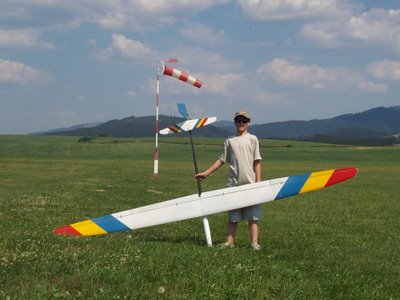John Godwin created the following summary of questions posed by Brian Mulder and answered by Mark Stockton and Craig Goodrum.
Brian Mulder raised questions about the latest F3J World Champs. Both
Mark and Craig replied. Here's an edited version of the conversation.
Mark's reply.
Q.. All scores that I have seen are normalized. This is of little
interest to me. What I want to know is does somebody or number of
people always max out every round irrespective of conditions? If not,
what is the norm per round time wise?
Generally all flights where maxed, in those that weren't, the winner
of the slot got very, very close with a 9:30 or so. This was quite an
achievement as we had overcast drizzly / rainy conditions for most of
the event. I can only think of two of my flights that where easy
maxes. After maxing out and on final approach, what error is there
for time? Are you always doing it within 1 second all the
time? Looking at it from another angle, if you are unable to land
within 1 second of max time when everybody maxes out, do you stand a chance?
Most rounds where won by pilots recording a 9:54 flight time and 1m
landing, once you include that the competitor spent 4 to 5 seconds on
tow, you realise that they are mostly landing very accurately at 9:59
(working time) within 1 meter of the spot. In a couple of rounds our
pilots recorded the same flight time as the slot winner, but landed
at 2m, this cost them on average 30 places in that round.
Q.. In unfavorable conditions, launch height counts. Do the guys
that launch high always come out on top in these conditions? In other
word, if you were not capable of launching as high, would you ever be
in contention for a podium position.
Even in unfavorable conditions, launch speed combined with height is
vital. I remember Arend Borst repeatedly achieving excellent heights
from 2 to 3 seconds. He wasn't the highest but always maximised the
flight time advantage every time. I don't believe we where ever out
launched by the others. Credit needs to go to Lionel and Paul here,
it was not by mistake they where chosen to tow for Aussie's in the fly-offs.
Q.. How much does unfavorable conditions impact overall on a
competition and who is going to win. If every round had zero lift
to be found, would certain individuals find it easier to win?
There is a definite technique to flying in these low lift conditions
that is vastly different to the techniques we use in the high lift,
high sink environment.
Q.. What planes were being flown? Other than the Supras and Pikes,
what else was being flown? I found it strange that this sort of
information was not listed anywhere on sites covering the WC. Was
anybody trying to compete with vac-bagged models and such like planes?
The top three planes flown where, 1) Pike Perfect - David Hobby, 2)
Xperience Pro - Sebastien Fleigel, 3) Supra - the Ralf Oetters. There
is very little to choose from between the top models. My intention is
to stick with the Supra's as they are as good as the other planes,
and they are being very actively developed by Vladimir with lots of
input from Arend Borst, Barry Kennedy, Joe Wurtz etc.
Q.. How much does LUCK contribute in a WC percentage wise?
You do not so much need good luck, but you certainly need to avoid
the bad luck. Having experienced team helps a lot here.
Q..Lastly, well done to our team for what they achieved. When, Joe
Wurts asks Graig to call for him ... hell that is something to be
proud off for sure. However, what would be the reason for not
possibly doing better. Where can the SA team improve or where are we
underachieving?
In short, we need to raise the level of competition here. The scores
Craig, Chris and myself recorded in nearly all slots would have
fairly easily won the slot here.
Regards
Mark
Craig's comments
To answer some of Brian's questions from a completely subjective view.
Yes, normally at least one pilot maxes. An excellent max is 9:57 and
1 m an OK max is 9:52 and 1m
Yes 1 second tolerance would normally enable a position in the
fly-offs. Most guys land 1 second early or at least at the beginning
of second 9:59. However time lost on launch may cost you as much as 3
seconds normally and even 5 seconds against a guy that pops off by
accident and manages to scrouge a thermal (just bad luck).
Yes the guys with the cleanest, lightest wing loading model that is
capable of a high launch would have an advantage in still air. When
there are lots of thermals the scores bunch up and when the
conditions are tough they scatter more. This worlds started with easy
conditions that had a tightly packed top 20 but there were some tough
rounds that led to top pilots having throw aways and when a bad patch
of weather came at the end the placings changed wildly. To get into
the fly off or top 12 you really need 11 rounds with a 9:54 and 1m
(even that does not guarantee a position so many guys push for 9:56
and 1m. I struggled with the continuous change in conditions, there
were always fronts and you could not settle on a particular cycle of
thermals. The biggest mistake was to do what the round before did
without having good reason. On the whole thermals there were as usual
more like those at Noodsburg than on the Reef, more soft and soggy.
Most of these guys fly in that all the time. Mark came second in his
group twice I think and still lost 2 or more minutes (or pushed for
extra time on the flight and lost landing, like me). To answer the
last part of the question I think the better guys find it easier to
win when conditions are difficult, when things are easy more people
get into the running.
Planes
There were a number of bagged Supras. I didn't see any other bagged
models. The main contenders for models, in no real order, were Supra,
Pike Superior,Pike Perfect, Vision, Experience Pro (like Paul flies),
Shadow, Espada, Stork II I think, Icons and a coupe of Tsunami's,
Escapes, some Ava's (in juniors only) and other built up stuff and
other from old and lastly my personal favourite - a single Crossfire
(not my advise for F3J though).
The ones that stand out for me are Pike Perfect, Supra, Icon (80 SQdm
at 1.8 kg). The home-made Supras were very competitive (Tom Kesling
flew these amoung others).
Luck helps some stay in the running and pushes some out. Most top 12
finishers are unaffected by luck but Jo was unlucky (almost costing
him a spot in the 12) and in my opinion Arend was lucky to get his
position in the fly-off.
To win you need some luck but in the fly-offs luck was not a factor.
To answer the question maybe 5%.
Reasons for poor performance.
Lack of model preparation in advance. I was preparing two models the
week before leaving and lost out on sleep.
Not enough landing timing practice - the extra load of juniors and
getting the future pilots up to a competitive level meant that a lot
of practice time both long before and the few days before the comp
was divided. We need people who can take the load of juniors off the
senior pilots. Given a choice I would still give up as much time to
juniors but it costs the seniors in preparation. I didn't have a
problem with workload on the field only before leaving. Chris missed
one landing coming in late and after that he flew safe - safe gets a
good team score but does nt get a top 12 placing.
Focus - not enough - pilots and team managers need to figure out
their roles and understand the mental game - try to involve only who
is needed indecisions and leave the others if possible.
Bad luck - Mark had pop offs in the first round that should not have
happened. This cost him an easy flight and one in the bag. The
problem was not poor prep as he was well prepared but during practice
both of his own models had tow hooks open up they reached the wrong
angle at exactly the wrong time (first round). This could have
happened the day before and it would have been fixed. Bad luck dude!
Launch height - never good enough, although we were pretty close this
time - the juniors were well below the average.
Heavy models - the juniors had models that were not right for light conditions.
Lines too thin in my opinion - there are many factors here.
Lastly
The cookie - sometimes it crumbles that way.
Regards
I look forward to seeing who tries out for the next team.
Craig
Tuesday, August 22, 2006
Thursday, August 17, 2006
Wednesday, August 16, 2006
The Day Roo Visited
Tuesday, August 15, 2006
African Pilot Supra
Friday, August 11, 2006
Photo Gallery
Ilma has posted her photographs of the event at http://www.f3x.za.org/gallery/F3J_World_Champs/index.html
Thursday, August 10, 2006
Cape Sailplanes and Vladimir save the day.
This is story detailing service excellence well above and beyond the norm.
Shortly after arriving in Slovakia, I experienced a strange radio failure with my number one Supra. This resulted in a heavy crash into a hops field next to the site. Most of the Supra survived, except the center section that was almost completely destroyed.
Frantic SMS's where sent to Craig and Michelle who where still in South Africa. Craig in turn contacted Mark Williams at Cape Sailplanes who in turn contacted Vladimir in the Ukraine. Vladimir almost immediately started laying up a new stiffer carbon center panel which was delivered to me personally three days later.
The plane was test flown the evening after the opening ceremony and performed perfectly for the entire event.
Many thanks for the excellent support and service.
Shortly after arriving in Slovakia, I experienced a strange radio failure with my number one Supra. This resulted in a heavy crash into a hops field next to the site. Most of the Supra survived, except the center section that was almost completely destroyed.
Frantic SMS's where sent to Craig and Michelle who where still in South Africa. Craig in turn contacted Mark Williams at Cape Sailplanes who in turn contacted Vladimir in the Ukraine. Vladimir almost immediately started laying up a new stiffer carbon center panel which was delivered to me personally three days later.
The plane was test flown the evening after the opening ceremony and performed perfectly for the entire event.
Many thanks for the excellent support and service.
Subscribe to:
Comments (Atom)
